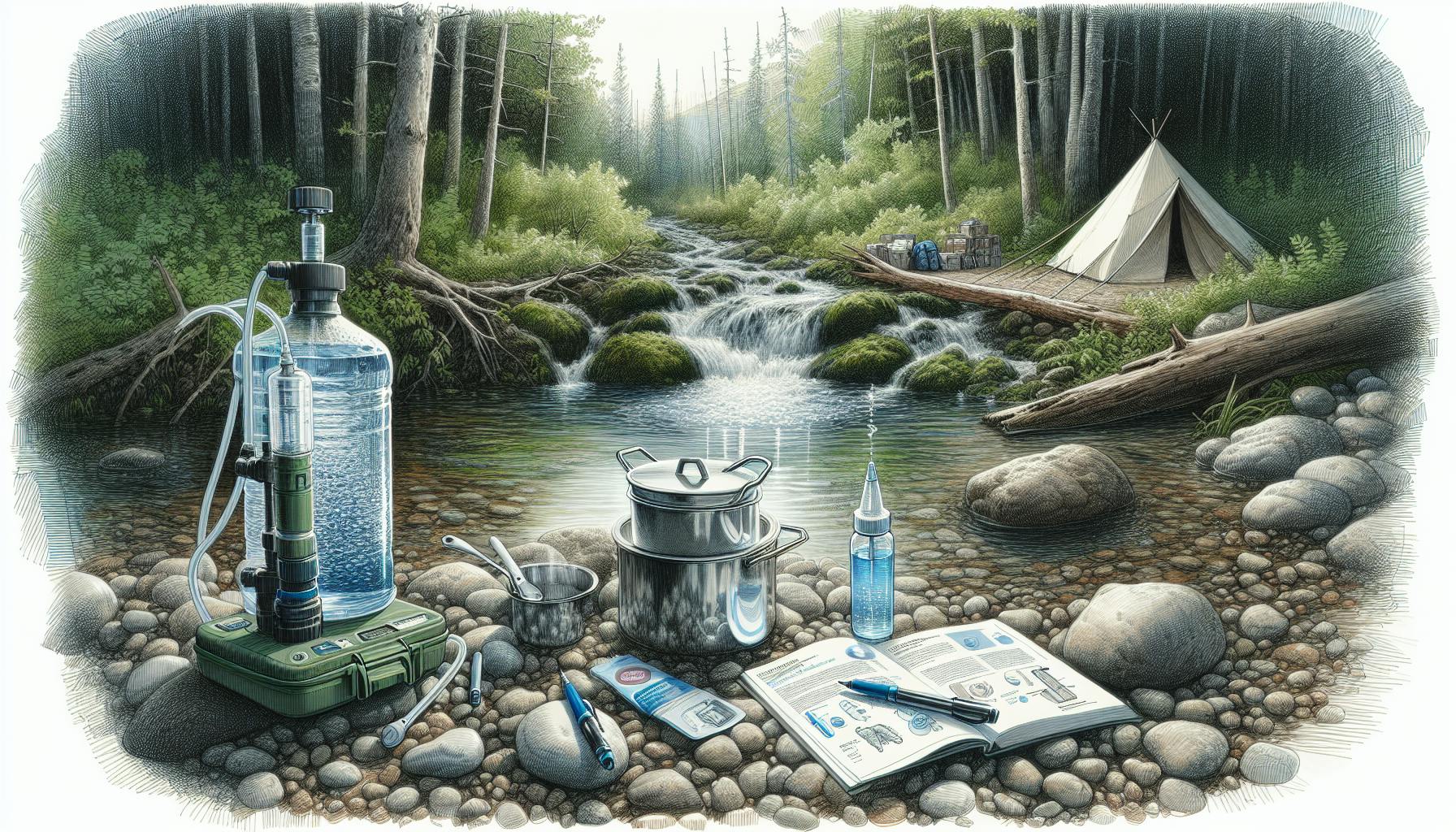When facing an emergency survival situation, most would agree that having effective signaling devices is critical for getting help.
By understanding the role of emergency flares, including proper use and limitations, you can significantly improve your chances of successfully signaling rescuers when it matters most.
In this article, we'll examine key considerations around emergency flares in survival contexts, from visibility and environmental factors to incorporation into survival kits alongside other key tools.
Introduction to Emergency Flares
Emergency flares are an essential tool for signaling distress and location in survival situations. When used properly, they can greatly increase your chances of being spotted and rescued. However, flares do have limitations that must be considered. This article provides an overview of emergency flares, including when and how to use them, as well as their restrictions.
Understanding Emergency Flares Meaning and Purpose
Emergency flares, sometimes called distress flares or signal flares, are pyrotechnic devices designed to attract attention, especially from aircraft and boats. They emit an extremely bright light and thick smoke to mark your location. The purpose of emergency flares is to visually show rescuers where you are so you can receive assistance. They are a universal sign of needing help and should only be used in life-threatening emergencies.
When to Use Emergency Flares
It's important to use flares at opportune times when they are most likely to be seen. Ideal occasions include:
- At night or in low-visibility conditions like fog or storms
- When you spot a search plane or helicopter nearby
- If you know a ground rescue team is in the vicinity
- To pinpoint your location after calling emergency services
Firing a flare when no one is around to see it will waste its short lifespan. Wait until you have the best chance of it being spotted.
How to Signal with Flares
Proper signaling technique is vital for emergency flares to work effectively:
- Fire them one at a time, straight up into the air for maximum visibility
- Allow each flare to fully burn out before launching another
- Use an internationally recognized pattern like three fires in a row to indicate distress
Position yourself in an open area without tree cover when firing flares so smoke and light can disperse widely. Stay upwind so smoke blows away from you.
Limitations of Emergency Flares
While flares can be invaluable signaling devices, they do have restrictions to consider:
- Limited battery life and expiration dates
- Potential fire hazard if misused or conditions are extremely dry
- Smoke and light may be obscured by weather events like rain, fog, and storms
- Smaller tactical flares may not be as visible from aircraft
Evaluate visibility factors and weather conditions before deciding to use one. Have backup signals like mirrors, whistles, and signal fires in case flares fail or aren't seen.
Storing and Maintaining Flares
To ensure your emergency flares work when needed:
- Store per manufacturer guidelines, usually in a cool, dry location
- Inspect regularly for corrosion, cracks, dents, or other damage
- Check expiration dates and replace as necessary
- Consider weatherproof storage containers and desiccant packs if in humid environments
Proper storage and maintenance keeps flares functional and ready for emergency use. Handle them carefully to prevent premature deployment or damage.
What is the meaning of emergency flares?
Emergency flares are pyrotechnic devices designed to emit bright light and smoke to signal distress in emergency situations. They serve several key purposes:
Signaling for Help
The primary function of emergency flares is to visually signal that you need help. The bright light and smoke make you more visible to rescuers, whether on land, air, or sea. Flares allow you to indicate your location from a distance.
Illumination
Flares provide illumination at night or in low visibility conditions. The intense light can aid search and rescue operations and help avoid hazards when visibility is poor.
Defensive Countermeasures
Flares also have defensive uses - their bright light can temporarily blind attackers or distract aggressive wildlife. The smoke can provide cover. This allows you to evade threats.
In civilian applications, hikers, mariners, drivers, and pilots carry emergency flares for signaling and illumination purposes. In military contexts, flares have defensive countermeasure applications as well.
Overall, flares serve a crucial role for visual signaling and illumination when electronic devices may be unavailable or inadequate. Understanding proper emergency flare use can save lives in survival situations.
What are the three main types of flares?
Emergency flares approved for distress signaling come in three main types:
Type A: Rocket Parachute Flares
- Launched high into air from a pen-shaped launcher
- Deploy a parachute and float down slowly
- Burn bright red for 40+ seconds at high altitude
- Visible for miles so ideal for open water/remote areas
Type B: Multi-Star Flares
- Launch 2-3 fiery red stars high into the air
- The stars burn very bright while floating down
- Each star visible for 5-7 seconds
- Good for closer range signaling
Type C: Hand-Held Flares
- Burn bright red flame for 60+ seconds
- Can be swung in circles to signal distress
- Shorter line-of-sight so best for close range
- Cheapest option
The type of flare depends on the situation. Rocket parachute flares reach the highest altitudes and are best for open water. Hand-held flares are more portable and cheaper but have shorter visibility. Choose the flare type based on intended use case and signaling distance needed.
Do they still make road flares?
Yes, road flares are still commonly manufactured and used for emergency situations on roads and highways. Some popular brands of road flares include:
-
Orion Safety Flares: Orion is one of the major manufacturers of road flares in the United States. They make 30-minute and 60-minute highway flares designed for high visibility and reliability.
-
Sirius Signal Flares: Sirius offers LED flares designed to be visible over 1 mile away. They offer extended burn times up to 120 minutes.
-
Cyalume Light Sticks: While not a traditional flare, Cyalume makes chemical light sticks that can be used as emergency markers. They offer visibility for up to 12 hours.
-
SOS Emergency Flares: SOS makes a variety of roadside flares including 30-minute red flares and 60-minute orange flares for traffic control.
Road flares remain an essential emergency tool for stopped vehicles to alert passing traffic of a hazard. They are inexpensive, reliable, and provide high visibility from all directions. Most road flares burn between 30-60 minutes, allowing time for help to arrive. For maximum safety, it's recommended to keep a set stored in vehicles at all times.
sbb-itb-b932644
Choosing the Best Emergency Flares
With different types of emergency flares available, how do you choose which are right for your situation? Key factors include intended use, weight, burn time, visibility, and cost.
Emergency Flares for Hiking: What to Look For
For hiking and overland survival situations, lightweight handheld flares you can carry in your pack offer an easily portable signaling option. Consider the following when selecting emergency flares for hiking:
-
Weight: Look for lightweight, compact flares that won't add much weight to your pack. Popular options weigh 3-5 oz.
-
Burn time: Aim for at least 60 seconds of burn time. This gives you enough time to wave and point the flare effectively.
-
All-weather capability: Make sure flares are waterproof and operable even in wind, rain, or snow.
-
Simplicity: Opt for simple, single-use pull pin activation so they're easy to operate in an emergency.
-
Cost: Balance cost vs. number of flares needed. Buy in multi-packs for economy.
Selecting Emergency Flares for Boats
To signal from a boat or raft, waterproof aerial flares that launch high in the air provide maximum visibility day or night. Consider:
-
Aerial height: Look for 300+ foot maximum height for visibility over distance.
-
Waterproof: Ensure flares float and resist moisture.
-
Stability: Pick flares with stabilizing fins to fly straight in wind.
-
Bright color: Red aerial flares are highly visible, especially at night.
-
Quantity: Stock multiple flares in case more are needed during rescue.
Evaluating Burn Time and Visibility
Look for flares that burn over 60 seconds and reach heights over 300 feet for best visibility. Red flares are most visible in low light conditions. However, also consider:
- Burn time needed for your situation
- Maximum altitude relative to terrain
- Brightness (candela rating)
- Color contrast with environment
Accounting for Environmental Factors
Consider potential wind, weather conditions, terrain, and other factors that could impact flare visibility and effectiveness when selecting emergency flares.
- Test flares outdoors first in likely conditions
- Have backup flares if signals are obscured
- Use flares judiciously if fire hazards exist
Cost Considerations for Emergency Flares
While an essential item, costs can add up when stocking multiple emergency flares. Carefully evaluate needs vs. budget when purchasing.
- Buy multi-packs for economy of scale
- Layer quantity - more for boats, less for hiking
- Consider reuseable flares if budget is tight
- Rotate stock as flares age/expire
Emergency flares are a critical signaling device to carry for wilderness survival or water rescue situations. Understanding selection factors like burn time, visibility, and environmental resilience allows you to choose the right emergency flares for your specific needs and conditions.
Using Emergency Flares Safely
While great signaling tools, flares can cause injuries or fires if used improperly. It's critical to follow all usage guidelines and safety precautions when handling emergency flares.
Following Manufacturer Guidelines for Flare Use
Before using any emergency flares, carefully read the instructions and warnings printed on the packaging. Pay close attention to:
- Expiration dates - Old or damaged flares may not ignite or burn properly
- Storage tips - Flares must be kept in a cool, dry area to remain functional
- Launch procedures - Know the proper way to ignite and hold the flare
Following the manufacturer's guidelines ensures flares work as intended when needed most.
Aiming Flares Properly to Ensure Safety
Only fire emergency flares straight up into the air. Never launch them at an angle towards people, buildings, trees, or other flammable objects. Angled flares can change direction unpredictably and cause collisions or accidental fires.
Maintaining Safe Distance from Burning Flares
When ignited, flares burn extremely hot - up to 1,200°F. Always maintain at least 5-10 feet of clearance when flares are active. Coming too close could result in severe burns for both people and wildlife.
Having Extinguishers Available When Using Flares
Have water or fire extinguishers nearby when launching emergency flares. Though uncommon, accidental brush fires can occur if flares land near dry vegetation. Extinguishers allow quick suppression of any unintended blazes.
Proper Disposal of Used Flares
After burning, properly dispose of used flares by submerging them in a bucket of water until completely cooled. Never throw spent flares in trash cans or leave them lying on the ground, as they could still reignite.
Following basic safety precautions keeps emergency flares a safe and effective rescue signaling tool. Handle flares carefully and responsibly at all times.
Incorporating Flares Into Survival Kits
Well-stocked survival kits should contain emergency signaling options like flares. Choose supplies wisely based on intended travel plans and pack space available.
Assembling a Roadside Emergency Car Kit with Flares
Including road flares in your vehicle's emergency kit is an essential preparation step. Along with jumper cables and LED road flares, road flares allow you to signal for help effectively if you experience a breakdown or accident while driving. Aim for road flares with a 30 minute burn time to ensure ongoing visibility.
Flares for Marine Survival Kits
For boats and other marine vessels, waterproof aerial flares and flare guns are critical signaling tools. The bright light and smoke provide maximum visibility if you need to call for rescue while on the water. Flare guns allow you to shoot signals high up for potential responders to spot. These flares are essential items for marine survival kits.
Pairing Flares with Other Signaling Tools
While extremely visible, road flares and aerial flares burn quickly, sometimes for only a few minutes. For this reason, pair flares with other longer-lasting signal options like mirrors, whistles, and dye markers. Having multiple tools expands your signaling capability if one option becomes unusable. Consider a signal mirror, whistle, and day/night distress flag to complement emergency flares.
Considering Road Flares with Extended Burn Time
When selecting road flares for a vehicle's emergency kit, prioritize options with an extended 30 minute burn time. This ensures ongoing visibility for passing drivers if you break down at roadside. It also gives rescuers more time to spot the signaling flare when responding. Models that burn for only 15-20 minutes may extinguish too quickly in remote areas.
Bulk Options: Road Flares 30 Minute 12 Pack
For those seeking to stock up on roadside emergency supplies, purchasing road flares in bulk quantities can offer cost savings. Opting for a 12 pack of 30 minute road flares ensures you have extras on hand while getting a better per unit price. Storing some flares in each vehicle and the rest at home builds resilience. Just check expiration dates occasionally when rotating stock.
Conclusion
Emergency flares are a critical component of any survival kit. When used properly, they can effectively signal rescuers when you are in distress. However, there are some key considerations when incorporating flares:
Key Takeaways on Emergency Flares in Survival Situations
-
Follow optimal signaling procedures - One flare burning for 60 seconds followed by a 60 second pause is the recommended signaling pattern. This balances visibility with conserving your limited flare supply.
-
Account for environmental factors - Consider how visible the flare will be given the time of day, weather conditions, surrounding terrain, etc. Adjust location and signaling patterns accordingly.
-
Use flares as a last resort - Emergency flares have limits, like battery life decays over time. Save flares for when you have confirmed signs of potential rescuers nearby.
-
Store flares properly - Keep flares in a watertight container and check expiration dates routinely. Store them securely to prevent accidental ignition.
By understanding both the value of emergency flares as well as their limitations, you can effectively incorporate them as one key component of your survival strategy. Used judiciously and paired with other signaling devices, they can make a real difference in an emergency.


